Health Promotion Program: Combating Obesity in Australian Youth
VerifiedAdded on 2023/06/06
|9
|2528
|140
Report
AI Summary
This report details a health promotion program targeting obesity prevention among youth aged 16-25 in Casino suburbs, Australia. The program aims to address the rising rates of obesity and overweight in this age group due to lifestyle changes and associated health risks such as type 2 diabetes and heart disease. Key objectives include encouraging physical exercise, promoting healthy eating habits, utilizing local resources, and mobilizing community involvement. Strategies involve regular health education sessions, promotion of fruit and vegetable consumption through collaboration with local farmers, and the involvement of dieticians, teachers, nurses, and volunteers. The program's success will be evaluated through surveys and interviews, with findings disseminated through peer-reviewed articles and media to encourage widespread adoption of healthy lifestyles. The nurses' roles in healthcare settings are also highlighted. Desklib provides access to similar solved assignments and study resources.
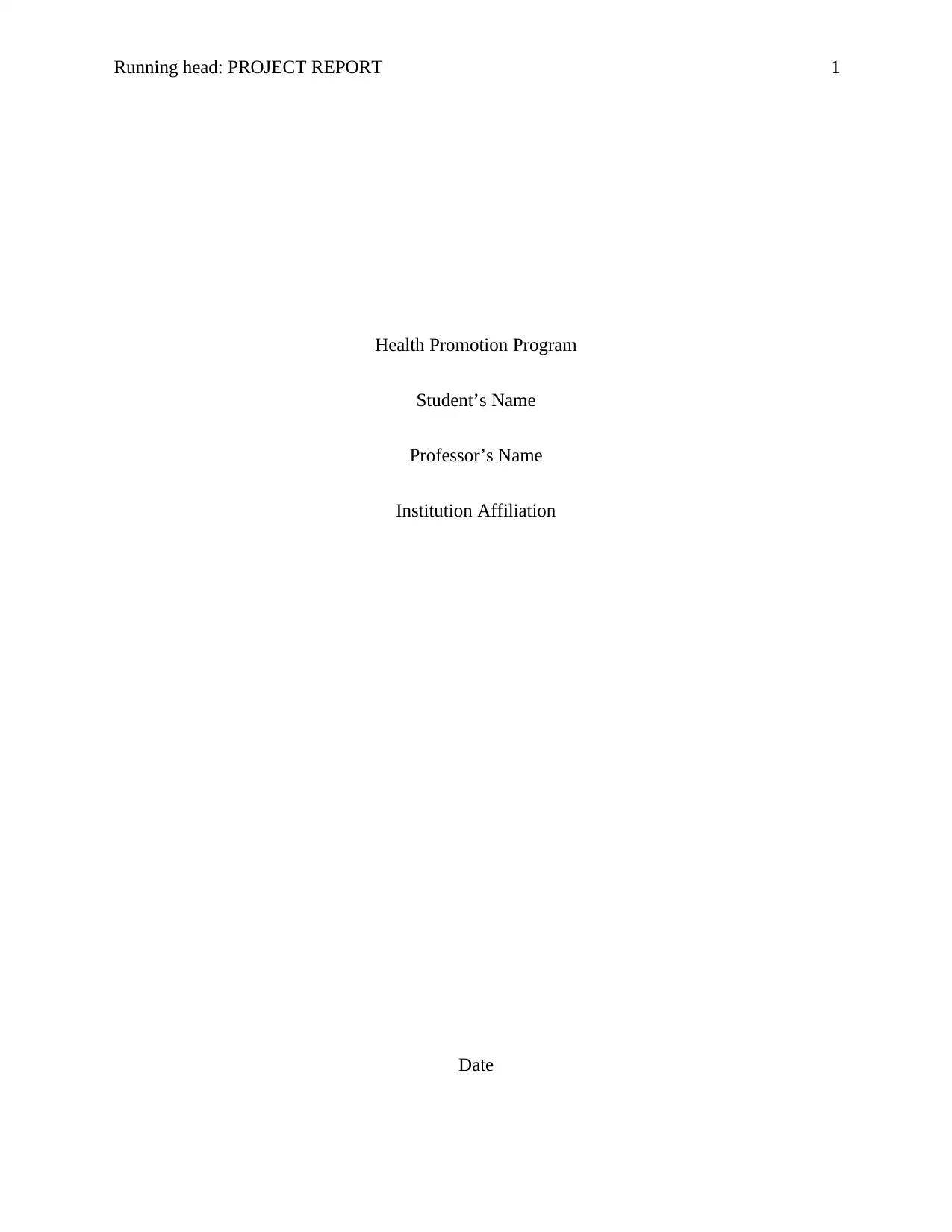
Running head: PROJECT REPORT 1
Health Promotion Program
Student’s Name
Professor’s Name
Institution Affiliation
Date
Health Promotion Program
Student’s Name
Professor’s Name
Institution Affiliation
Date
Paraphrase This Document
Need a fresh take? Get an instant paraphrase of this document with our AI Paraphraser
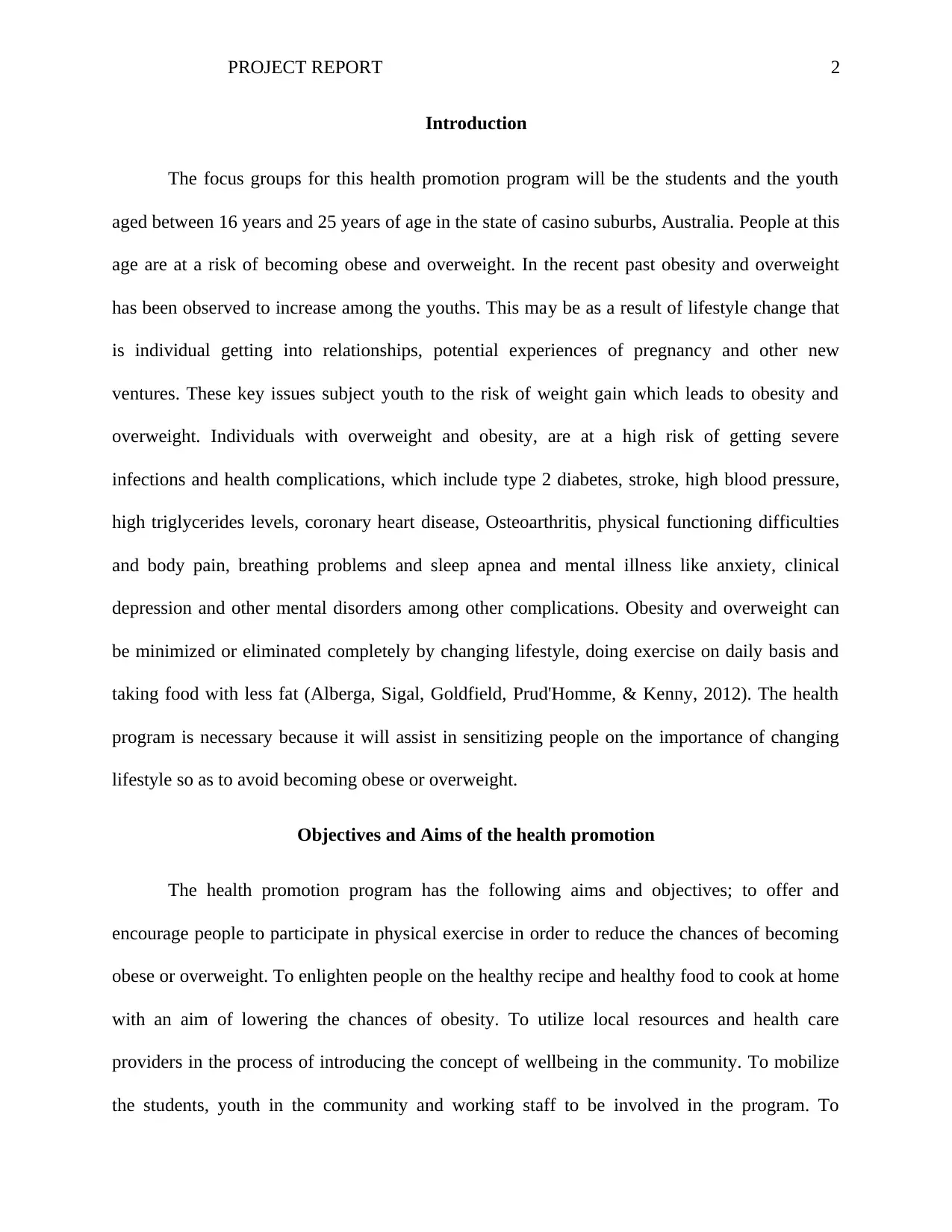
PROJECT REPORT 2
Introduction
The focus groups for this health promotion program will be the students and the youth
aged between 16 years and 25 years of age in the state of casino suburbs, Australia. People at this
age are at a risk of becoming obese and overweight. In the recent past obesity and overweight
has been observed to increase among the youths. This may be as a result of lifestyle change that
is individual getting into relationships, potential experiences of pregnancy and other new
ventures. These key issues subject youth to the risk of weight gain which leads to obesity and
overweight. Individuals with overweight and obesity, are at a high risk of getting severe
infections and health complications, which include type 2 diabetes, stroke, high blood pressure,
high triglycerides levels, coronary heart disease, Osteoarthritis, physical functioning difficulties
and body pain, breathing problems and sleep apnea and mental illness like anxiety, clinical
depression and other mental disorders among other complications. Obesity and overweight can
be minimized or eliminated completely by changing lifestyle, doing exercise on daily basis and
taking food with less fat (Alberga, Sigal, Goldfield, Prud'Homme, & Kenny, 2012). The health
program is necessary because it will assist in sensitizing people on the importance of changing
lifestyle so as to avoid becoming obese or overweight.
Objectives and Aims of the health promotion
The health promotion program has the following aims and objectives; to offer and
encourage people to participate in physical exercise in order to reduce the chances of becoming
obese or overweight. To enlighten people on the healthy recipe and healthy food to cook at home
with an aim of lowering the chances of obesity. To utilize local resources and health care
providers in the process of introducing the concept of wellbeing in the community. To mobilize
the students, youth in the community and working staff to be involved in the program. To
Introduction
The focus groups for this health promotion program will be the students and the youth
aged between 16 years and 25 years of age in the state of casino suburbs, Australia. People at this
age are at a risk of becoming obese and overweight. In the recent past obesity and overweight
has been observed to increase among the youths. This may be as a result of lifestyle change that
is individual getting into relationships, potential experiences of pregnancy and other new
ventures. These key issues subject youth to the risk of weight gain which leads to obesity and
overweight. Individuals with overweight and obesity, are at a high risk of getting severe
infections and health complications, which include type 2 diabetes, stroke, high blood pressure,
high triglycerides levels, coronary heart disease, Osteoarthritis, physical functioning difficulties
and body pain, breathing problems and sleep apnea and mental illness like anxiety, clinical
depression and other mental disorders among other complications. Obesity and overweight can
be minimized or eliminated completely by changing lifestyle, doing exercise on daily basis and
taking food with less fat (Alberga, Sigal, Goldfield, Prud'Homme, & Kenny, 2012). The health
program is necessary because it will assist in sensitizing people on the importance of changing
lifestyle so as to avoid becoming obese or overweight.
Objectives and Aims of the health promotion
The health promotion program has the following aims and objectives; to offer and
encourage people to participate in physical exercise in order to reduce the chances of becoming
obese or overweight. To enlighten people on the healthy recipe and healthy food to cook at home
with an aim of lowering the chances of obesity. To utilize local resources and health care
providers in the process of introducing the concept of wellbeing in the community. To mobilize
the students, youth in the community and working staff to be involved in the program. To
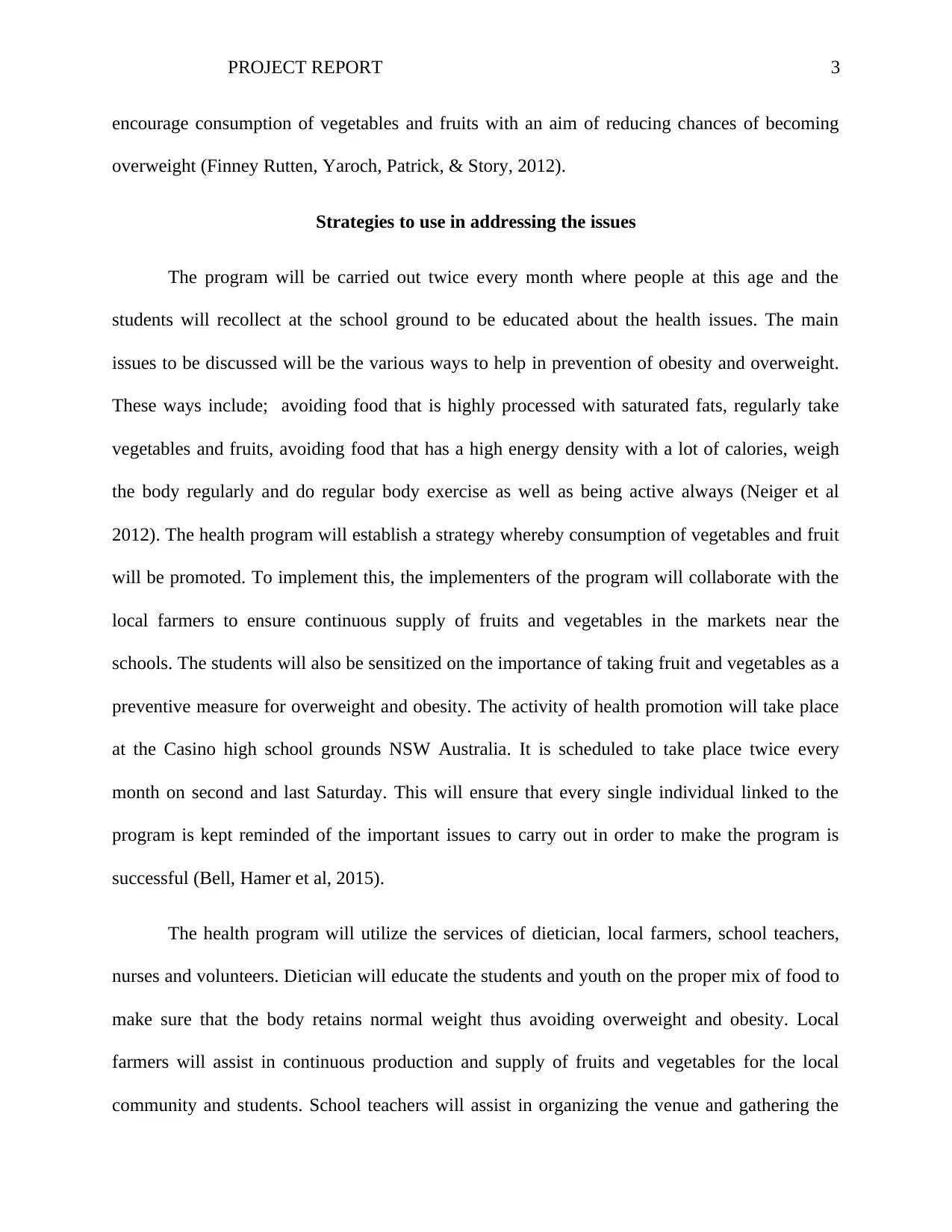
PROJECT REPORT 3
encourage consumption of vegetables and fruits with an aim of reducing chances of becoming
overweight (Finney Rutten, Yaroch, Patrick, & Story, 2012).
Strategies to use in addressing the issues
The program will be carried out twice every month where people at this age and the
students will recollect at the school ground to be educated about the health issues. The main
issues to be discussed will be the various ways to help in prevention of obesity and overweight.
These ways include; avoiding food that is highly processed with saturated fats, regularly take
vegetables and fruits, avoiding food that has a high energy density with a lot of calories, weigh
the body regularly and do regular body exercise as well as being active always (Neiger et al
2012). The health program will establish a strategy whereby consumption of vegetables and fruit
will be promoted. To implement this, the implementers of the program will collaborate with the
local farmers to ensure continuous supply of fruits and vegetables in the markets near the
schools. The students will also be sensitized on the importance of taking fruit and vegetables as a
preventive measure for overweight and obesity. The activity of health promotion will take place
at the Casino high school grounds NSW Australia. It is scheduled to take place twice every
month on second and last Saturday. This will ensure that every single individual linked to the
program is kept reminded of the important issues to carry out in order to make the program is
successful (Bell, Hamer et al, 2015).
The health program will utilize the services of dietician, local farmers, school teachers,
nurses and volunteers. Dietician will educate the students and youth on the proper mix of food to
make sure that the body retains normal weight thus avoiding overweight and obesity. Local
farmers will assist in continuous production and supply of fruits and vegetables for the local
community and students. School teachers will assist in organizing the venue and gathering the
encourage consumption of vegetables and fruits with an aim of reducing chances of becoming
overweight (Finney Rutten, Yaroch, Patrick, & Story, 2012).
Strategies to use in addressing the issues
The program will be carried out twice every month where people at this age and the
students will recollect at the school ground to be educated about the health issues. The main
issues to be discussed will be the various ways to help in prevention of obesity and overweight.
These ways include; avoiding food that is highly processed with saturated fats, regularly take
vegetables and fruits, avoiding food that has a high energy density with a lot of calories, weigh
the body regularly and do regular body exercise as well as being active always (Neiger et al
2012). The health program will establish a strategy whereby consumption of vegetables and fruit
will be promoted. To implement this, the implementers of the program will collaborate with the
local farmers to ensure continuous supply of fruits and vegetables in the markets near the
schools. The students will also be sensitized on the importance of taking fruit and vegetables as a
preventive measure for overweight and obesity. The activity of health promotion will take place
at the Casino high school grounds NSW Australia. It is scheduled to take place twice every
month on second and last Saturday. This will ensure that every single individual linked to the
program is kept reminded of the important issues to carry out in order to make the program is
successful (Bell, Hamer et al, 2015).
The health program will utilize the services of dietician, local farmers, school teachers,
nurses and volunteers. Dietician will educate the students and youth on the proper mix of food to
make sure that the body retains normal weight thus avoiding overweight and obesity. Local
farmers will assist in continuous production and supply of fruits and vegetables for the local
community and students. School teachers will assist in organizing the venue and gathering the
⊘ This is a preview!⊘
Do you want full access?
Subscribe today to unlock all pages.

Trusted by 1+ million students worldwide

PROJECT REPORT 4
students and youths together for the program. Nurses will assist in assessing and advising the
people with disorder and those without disorder and also enlightening the community and
students on healthy living. Volunteers will assist in other activities like security, providing public
address instruments among other functions (Kramer, Zinman, & Retnakaran, 2013).
This is an interdisciplinary program because there is collaboration among different
disciplines like NSW education department, teachers, dietician and local farmers. The NSW
education department has the duty of advertising the event to the students and the community at
large and to authorize the use of school facilities. The local farmers, teachers and dieticians will
supplement the program. To carry out the activities of the program, various costs will be incurred
which include; advertising cost, paying specialists like dietician, nurses and teachers, paying for
public address instruments among other costs. However, negotiating with NSW education
department to use the school grounds on weekends will reduce the cost because the program
benefits the students and the community at large hence no need to pay for the facility. In addition
the local farmers will be requested to volunteer for the program because they are likely to benefit
by selling their products to the students (Grover et al 2015).
When implementing the program every individual will be considered and treated as
unique and be highly valued no matter their social or political class. The program will be
sensitive to the authority and also the people in power will be accorded their respect as well. The
program will be cultural sensitive and non-discriminatory. The program will also endeavor to
address the needs of the participants in an effective, ethical and efficient way. Any information
obtained from individual will be held with confidentiality and will not be shared with anyone.
The time for developing the program, implementing it and evaluating the outcome will be
students and youths together for the program. Nurses will assist in assessing and advising the
people with disorder and those without disorder and also enlightening the community and
students on healthy living. Volunteers will assist in other activities like security, providing public
address instruments among other functions (Kramer, Zinman, & Retnakaran, 2013).
This is an interdisciplinary program because there is collaboration among different
disciplines like NSW education department, teachers, dietician and local farmers. The NSW
education department has the duty of advertising the event to the students and the community at
large and to authorize the use of school facilities. The local farmers, teachers and dieticians will
supplement the program. To carry out the activities of the program, various costs will be incurred
which include; advertising cost, paying specialists like dietician, nurses and teachers, paying for
public address instruments among other costs. However, negotiating with NSW education
department to use the school grounds on weekends will reduce the cost because the program
benefits the students and the community at large hence no need to pay for the facility. In addition
the local farmers will be requested to volunteer for the program because they are likely to benefit
by selling their products to the students (Grover et al 2015).
When implementing the program every individual will be considered and treated as
unique and be highly valued no matter their social or political class. The program will be
sensitive to the authority and also the people in power will be accorded their respect as well. The
program will be cultural sensitive and non-discriminatory. The program will also endeavor to
address the needs of the participants in an effective, ethical and efficient way. Any information
obtained from individual will be held with confidentiality and will not be shared with anyone.
The time for developing the program, implementing it and evaluating the outcome will be
Paraphrase This Document
Need a fresh take? Get an instant paraphrase of this document with our AI Paraphraser
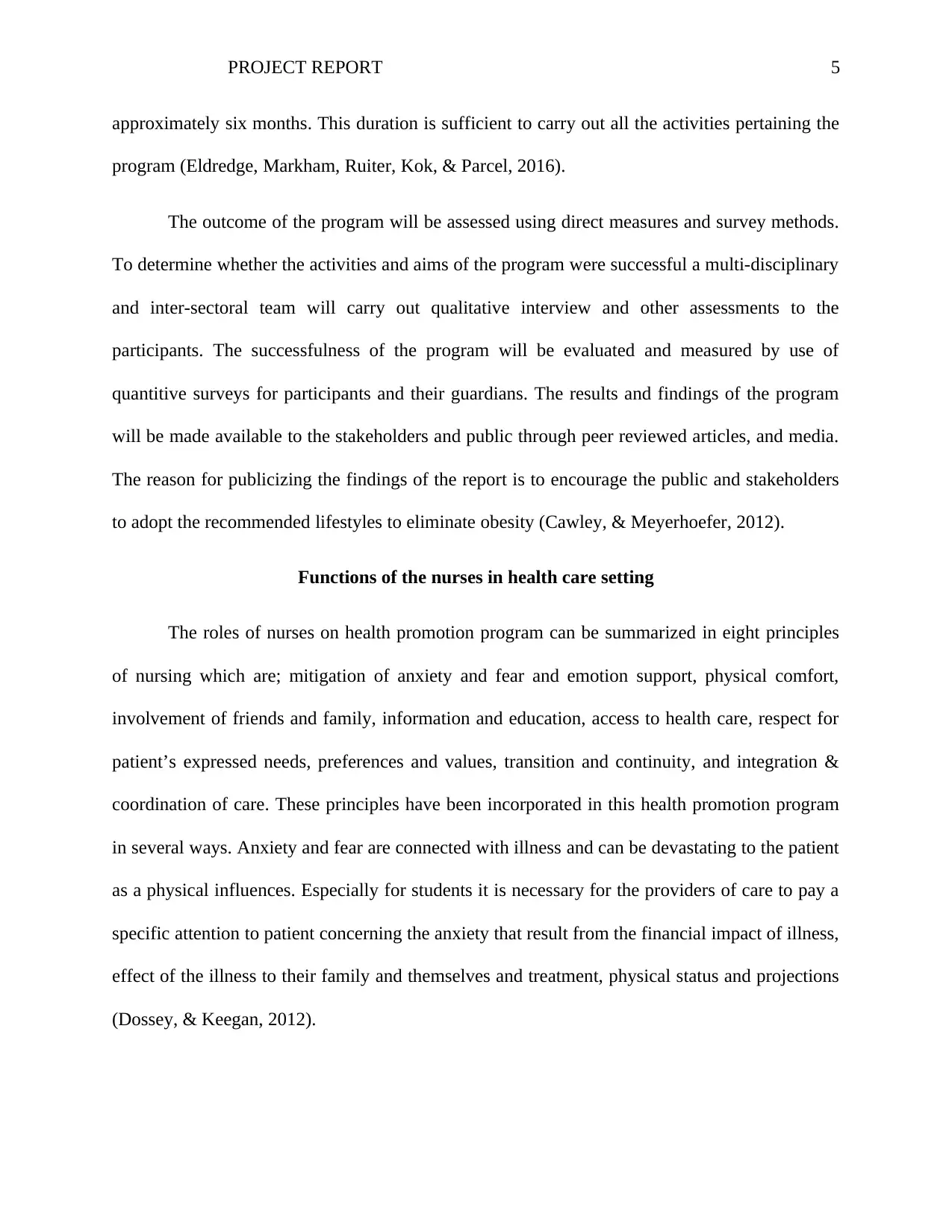
PROJECT REPORT 5
approximately six months. This duration is sufficient to carry out all the activities pertaining the
program (Eldredge, Markham, Ruiter, Kok, & Parcel, 2016).
The outcome of the program will be assessed using direct measures and survey methods.
To determine whether the activities and aims of the program were successful a multi-disciplinary
and inter-sectoral team will carry out qualitative interview and other assessments to the
participants. The successfulness of the program will be evaluated and measured by use of
quantitive surveys for participants and their guardians. The results and findings of the program
will be made available to the stakeholders and public through peer reviewed articles, and media.
The reason for publicizing the findings of the report is to encourage the public and stakeholders
to adopt the recommended lifestyles to eliminate obesity (Cawley, & Meyerhoefer, 2012).
Functions of the nurses in health care setting
The roles of nurses on health promotion program can be summarized in eight principles
of nursing which are; mitigation of anxiety and fear and emotion support, physical comfort,
involvement of friends and family, information and education, access to health care, respect for
patient’s expressed needs, preferences and values, transition and continuity, and integration &
coordination of care. These principles have been incorporated in this health promotion program
in several ways. Anxiety and fear are connected with illness and can be devastating to the patient
as a physical influences. Especially for students it is necessary for the providers of care to pay a
specific attention to patient concerning the anxiety that result from the financial impact of illness,
effect of the illness to their family and themselves and treatment, physical status and projections
(Dossey, & Keegan, 2012).
approximately six months. This duration is sufficient to carry out all the activities pertaining the
program (Eldredge, Markham, Ruiter, Kok, & Parcel, 2016).
The outcome of the program will be assessed using direct measures and survey methods.
To determine whether the activities and aims of the program were successful a multi-disciplinary
and inter-sectoral team will carry out qualitative interview and other assessments to the
participants. The successfulness of the program will be evaluated and measured by use of
quantitive surveys for participants and their guardians. The results and findings of the program
will be made available to the stakeholders and public through peer reviewed articles, and media.
The reason for publicizing the findings of the report is to encourage the public and stakeholders
to adopt the recommended lifestyles to eliminate obesity (Cawley, & Meyerhoefer, 2012).
Functions of the nurses in health care setting
The roles of nurses on health promotion program can be summarized in eight principles
of nursing which are; mitigation of anxiety and fear and emotion support, physical comfort,
involvement of friends and family, information and education, access to health care, respect for
patient’s expressed needs, preferences and values, transition and continuity, and integration &
coordination of care. These principles have been incorporated in this health promotion program
in several ways. Anxiety and fear are connected with illness and can be devastating to the patient
as a physical influences. Especially for students it is necessary for the providers of care to pay a
specific attention to patient concerning the anxiety that result from the financial impact of illness,
effect of the illness to their family and themselves and treatment, physical status and projections
(Dossey, & Keegan, 2012).
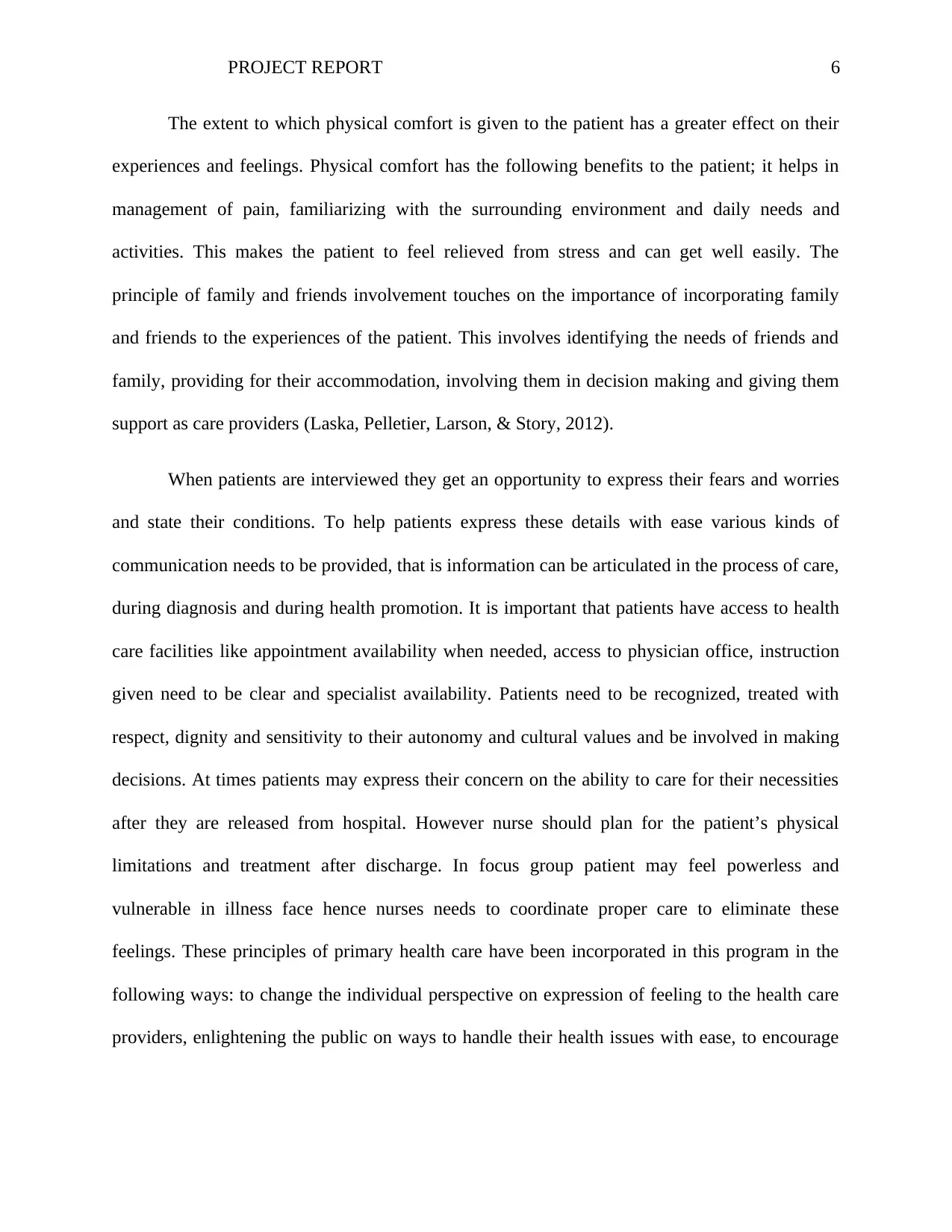
PROJECT REPORT 6
The extent to which physical comfort is given to the patient has a greater effect on their
experiences and feelings. Physical comfort has the following benefits to the patient; it helps in
management of pain, familiarizing with the surrounding environment and daily needs and
activities. This makes the patient to feel relieved from stress and can get well easily. The
principle of family and friends involvement touches on the importance of incorporating family
and friends to the experiences of the patient. This involves identifying the needs of friends and
family, providing for their accommodation, involving them in decision making and giving them
support as care providers (Laska, Pelletier, Larson, & Story, 2012).
When patients are interviewed they get an opportunity to express their fears and worries
and state their conditions. To help patients express these details with ease various kinds of
communication needs to be provided, that is information can be articulated in the process of care,
during diagnosis and during health promotion. It is important that patients have access to health
care facilities like appointment availability when needed, access to physician office, instruction
given need to be clear and specialist availability. Patients need to be recognized, treated with
respect, dignity and sensitivity to their autonomy and cultural values and be involved in making
decisions. At times patients may express their concern on the ability to care for their necessities
after they are released from hospital. However nurse should plan for the patient’s physical
limitations and treatment after discharge. In focus group patient may feel powerless and
vulnerable in illness face hence nurses needs to coordinate proper care to eliminate these
feelings. These principles of primary health care have been incorporated in this program in the
following ways: to change the individual perspective on expression of feeling to the health care
providers, enlightening the public on ways to handle their health issues with ease, to encourage
The extent to which physical comfort is given to the patient has a greater effect on their
experiences and feelings. Physical comfort has the following benefits to the patient; it helps in
management of pain, familiarizing with the surrounding environment and daily needs and
activities. This makes the patient to feel relieved from stress and can get well easily. The
principle of family and friends involvement touches on the importance of incorporating family
and friends to the experiences of the patient. This involves identifying the needs of friends and
family, providing for their accommodation, involving them in decision making and giving them
support as care providers (Laska, Pelletier, Larson, & Story, 2012).
When patients are interviewed they get an opportunity to express their fears and worries
and state their conditions. To help patients express these details with ease various kinds of
communication needs to be provided, that is information can be articulated in the process of care,
during diagnosis and during health promotion. It is important that patients have access to health
care facilities like appointment availability when needed, access to physician office, instruction
given need to be clear and specialist availability. Patients need to be recognized, treated with
respect, dignity and sensitivity to their autonomy and cultural values and be involved in making
decisions. At times patients may express their concern on the ability to care for their necessities
after they are released from hospital. However nurse should plan for the patient’s physical
limitations and treatment after discharge. In focus group patient may feel powerless and
vulnerable in illness face hence nurses needs to coordinate proper care to eliminate these
feelings. These principles of primary health care have been incorporated in this program in the
following ways: to change the individual perspective on expression of feeling to the health care
providers, enlightening the public on ways to handle their health issues with ease, to encourage
⊘ This is a preview!⊘
Do you want full access?
Subscribe today to unlock all pages.

Trusted by 1+ million students worldwide
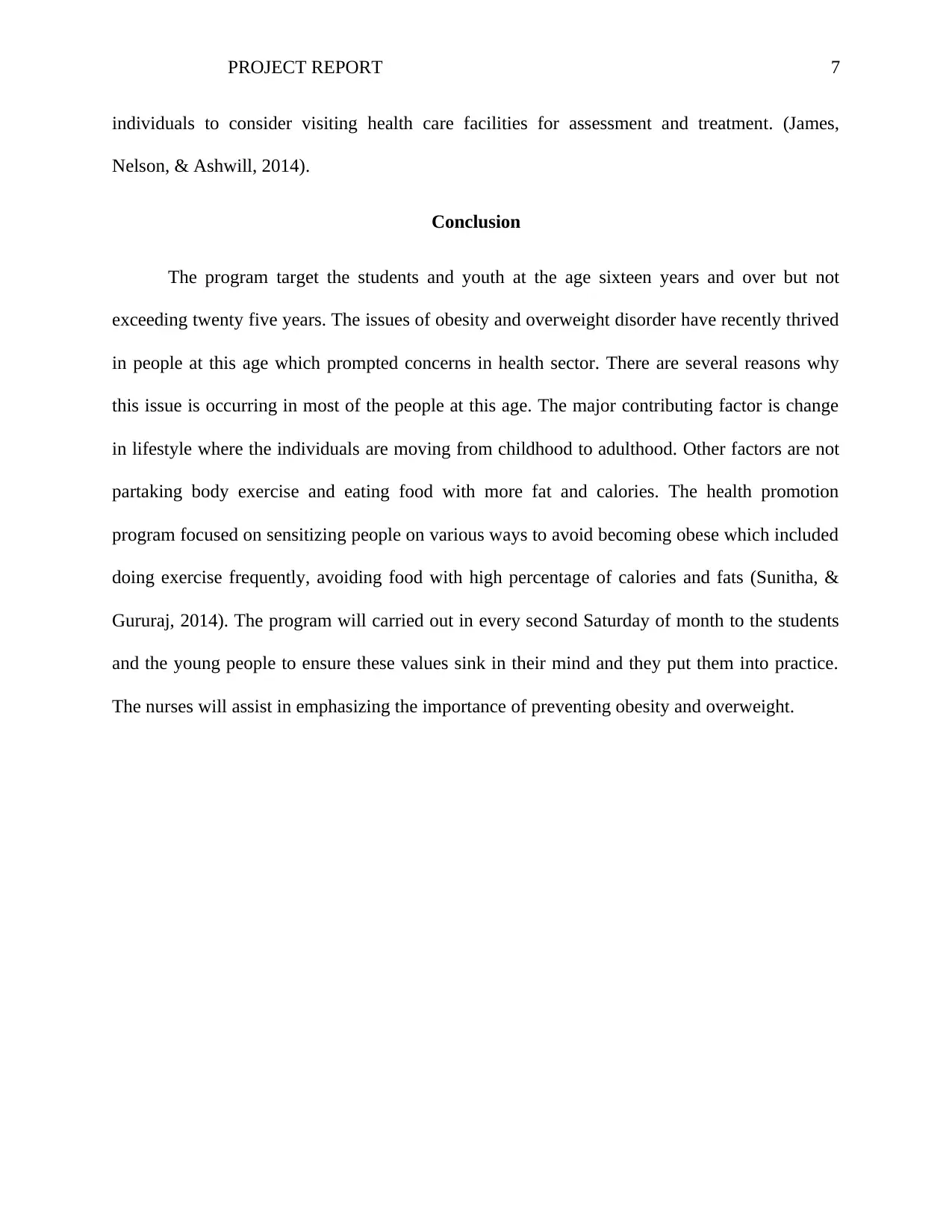
PROJECT REPORT 7
individuals to consider visiting health care facilities for assessment and treatment. (James,
Nelson, & Ashwill, 2014).
Conclusion
The program target the students and youth at the age sixteen years and over but not
exceeding twenty five years. The issues of obesity and overweight disorder have recently thrived
in people at this age which prompted concerns in health sector. There are several reasons why
this issue is occurring in most of the people at this age. The major contributing factor is change
in lifestyle where the individuals are moving from childhood to adulthood. Other factors are not
partaking body exercise and eating food with more fat and calories. The health promotion
program focused on sensitizing people on various ways to avoid becoming obese which included
doing exercise frequently, avoiding food with high percentage of calories and fats (Sunitha, &
Gururaj, 2014). The program will carried out in every second Saturday of month to the students
and the young people to ensure these values sink in their mind and they put them into practice.
The nurses will assist in emphasizing the importance of preventing obesity and overweight.
individuals to consider visiting health care facilities for assessment and treatment. (James,
Nelson, & Ashwill, 2014).
Conclusion
The program target the students and youth at the age sixteen years and over but not
exceeding twenty five years. The issues of obesity and overweight disorder have recently thrived
in people at this age which prompted concerns in health sector. There are several reasons why
this issue is occurring in most of the people at this age. The major contributing factor is change
in lifestyle where the individuals are moving from childhood to adulthood. Other factors are not
partaking body exercise and eating food with more fat and calories. The health promotion
program focused on sensitizing people on various ways to avoid becoming obese which included
doing exercise frequently, avoiding food with high percentage of calories and fats (Sunitha, &
Gururaj, 2014). The program will carried out in every second Saturday of month to the students
and the young people to ensure these values sink in their mind and they put them into practice.
The nurses will assist in emphasizing the importance of preventing obesity and overweight.
Paraphrase This Document
Need a fresh take? Get an instant paraphrase of this document with our AI Paraphraser

PROJECT REPORT 8
References
Alberga, A. S., Sigal, R. J., Goldfield, G., Prud'Homme, D., & Kenny, G. P. (2012). Overweight
and obese teenagers: why is adolescence a critical period?. Pediatric obesity, 7(4), 261-
273.
Bell, J. A., Hamer, M., van Hees, V. T., Singh-Manoux, A., Kivimäki, M., & Sabia, S. (2015).
Healthy obesity and objective physical activity–. The American journal of clinical
nutrition, 102(2), 268-275.
Cawley, J., & Meyerhoefer, C. (2012). The medical care costs of obesity: an instrumental
variables approach. Journal of health economics, 31(1), 219-230.
Dossey, B. M., & Keegan, L. (2012). Holistic nursing. Jones & Bartlett Publishers.
Eldredge, L. K. B., Markham, C. M., Ruiter, R. A., Kok, G., & Parcel, G. S. (2016). Planning
health promotion programs: an intervention mapping approach. John Wiley & Sons.
Finney Rutten, L., Yaroch, A. L., Patrick, H., & Story, M. (2012). Obesity prevention and
national food security: a food systems approach. ISRN Public Health, 2012.
Grover, S. A., Kaouache, M., Rempel, P., Joseph, L., Dawes, M., Lau, D. C., & Lowensteyn, I.
(2015). Years of life lost and healthy life-years lost from diabetes and cardiovascular
disease in overweight and obese people: a modelling study. The lancet Diabetes &
endocrinology, 3(2), 114-122.
James, S. R., Nelson, K., & Ashwill, J. (2014). Nursing care of children-E-book: principles and
practice. Elsevier Health Sciences.
References
Alberga, A. S., Sigal, R. J., Goldfield, G., Prud'Homme, D., & Kenny, G. P. (2012). Overweight
and obese teenagers: why is adolescence a critical period?. Pediatric obesity, 7(4), 261-
273.
Bell, J. A., Hamer, M., van Hees, V. T., Singh-Manoux, A., Kivimäki, M., & Sabia, S. (2015).
Healthy obesity and objective physical activity–. The American journal of clinical
nutrition, 102(2), 268-275.
Cawley, J., & Meyerhoefer, C. (2012). The medical care costs of obesity: an instrumental
variables approach. Journal of health economics, 31(1), 219-230.
Dossey, B. M., & Keegan, L. (2012). Holistic nursing. Jones & Bartlett Publishers.
Eldredge, L. K. B., Markham, C. M., Ruiter, R. A., Kok, G., & Parcel, G. S. (2016). Planning
health promotion programs: an intervention mapping approach. John Wiley & Sons.
Finney Rutten, L., Yaroch, A. L., Patrick, H., & Story, M. (2012). Obesity prevention and
national food security: a food systems approach. ISRN Public Health, 2012.
Grover, S. A., Kaouache, M., Rempel, P., Joseph, L., Dawes, M., Lau, D. C., & Lowensteyn, I.
(2015). Years of life lost and healthy life-years lost from diabetes and cardiovascular
disease in overweight and obese people: a modelling study. The lancet Diabetes &
endocrinology, 3(2), 114-122.
James, S. R., Nelson, K., & Ashwill, J. (2014). Nursing care of children-E-book: principles and
practice. Elsevier Health Sciences.
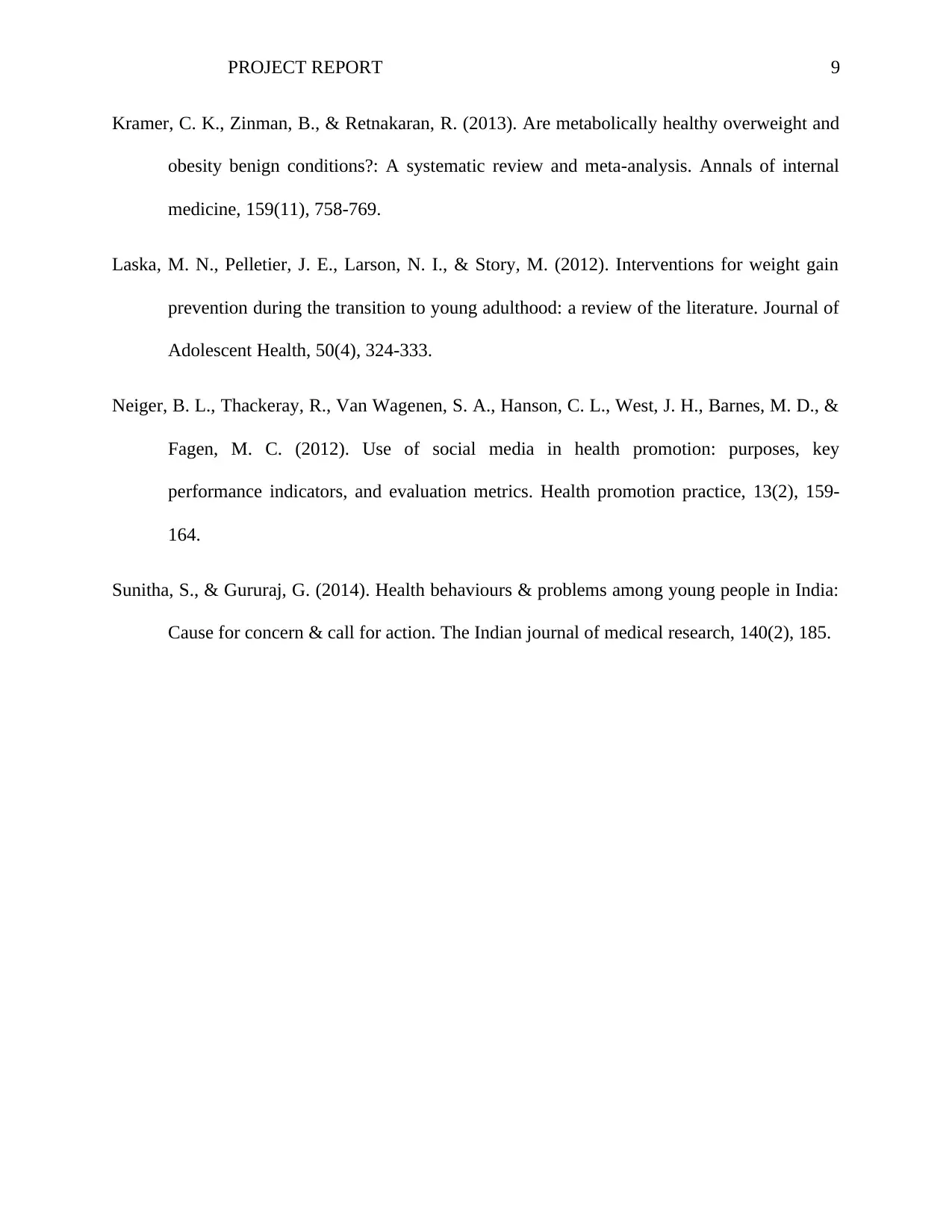
PROJECT REPORT 9
Kramer, C. K., Zinman, B., & Retnakaran, R. (2013). Are metabolically healthy overweight and
obesity benign conditions?: A systematic review and meta-analysis. Annals of internal
medicine, 159(11), 758-769.
Laska, M. N., Pelletier, J. E., Larson, N. I., & Story, M. (2012). Interventions for weight gain
prevention during the transition to young adulthood: a review of the literature. Journal of
Adolescent Health, 50(4), 324-333.
Neiger, B. L., Thackeray, R., Van Wagenen, S. A., Hanson, C. L., West, J. H., Barnes, M. D., &
Fagen, M. C. (2012). Use of social media in health promotion: purposes, key
performance indicators, and evaluation metrics. Health promotion practice, 13(2), 159-
164.
Sunitha, S., & Gururaj, G. (2014). Health behaviours & problems among young people in India:
Cause for concern & call for action. The Indian journal of medical research, 140(2), 185.
Kramer, C. K., Zinman, B., & Retnakaran, R. (2013). Are metabolically healthy overweight and
obesity benign conditions?: A systematic review and meta-analysis. Annals of internal
medicine, 159(11), 758-769.
Laska, M. N., Pelletier, J. E., Larson, N. I., & Story, M. (2012). Interventions for weight gain
prevention during the transition to young adulthood: a review of the literature. Journal of
Adolescent Health, 50(4), 324-333.
Neiger, B. L., Thackeray, R., Van Wagenen, S. A., Hanson, C. L., West, J. H., Barnes, M. D., &
Fagen, M. C. (2012). Use of social media in health promotion: purposes, key
performance indicators, and evaluation metrics. Health promotion practice, 13(2), 159-
164.
Sunitha, S., & Gururaj, G. (2014). Health behaviours & problems among young people in India:
Cause for concern & call for action. The Indian journal of medical research, 140(2), 185.
⊘ This is a preview!⊘
Do you want full access?
Subscribe today to unlock all pages.

Trusted by 1+ million students worldwide
1 out of 9
Related Documents
Your All-in-One AI-Powered Toolkit for Academic Success.
+13062052269
info@desklib.com
Available 24*7 on WhatsApp / Email
![[object Object]](/_next/static/media/star-bottom.7253800d.svg)
Unlock your academic potential
Copyright © 2020–2025 A2Z Services. All Rights Reserved. Developed and managed by ZUCOL.





